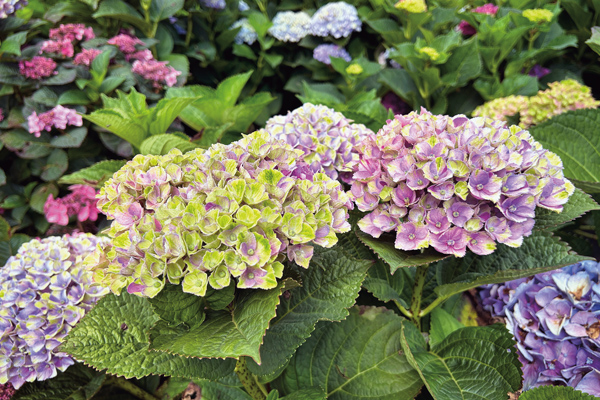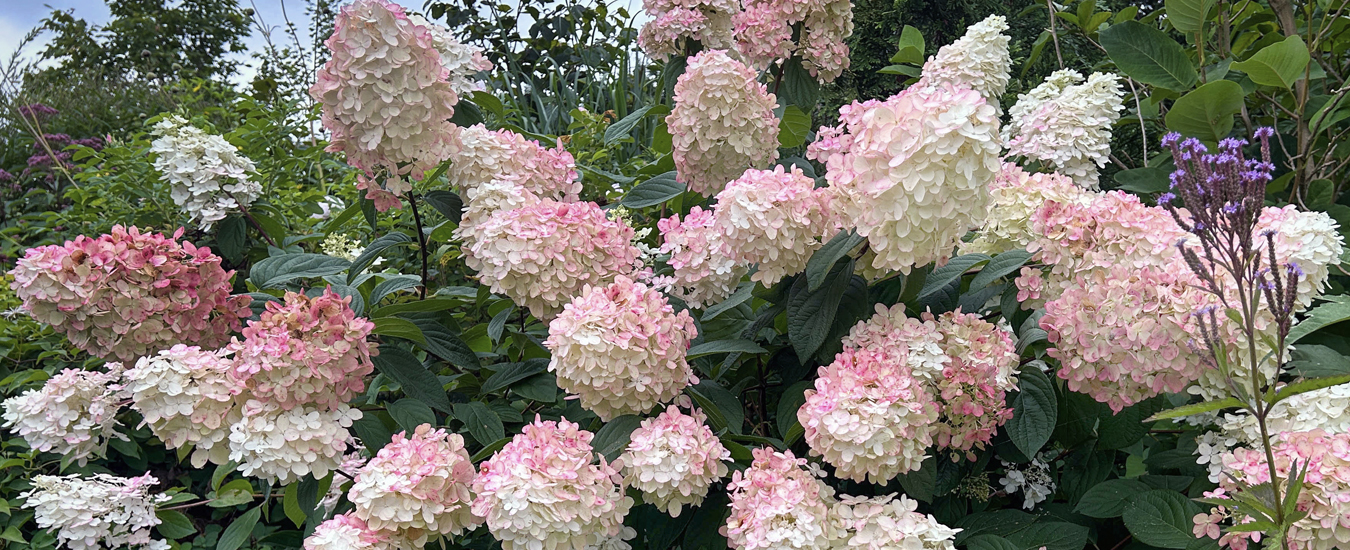Hydrangeas grow quickly, often putting on as much as a metre in height a year. Flowers start in early summer, depending on variety, and can last into autumn. Some types dry well and are used in wreaths and arrangements. There are dwarf hydrangeas, ideal for small spaces, and others that grow more than three metres tall. Some types have great fall foliage colour.
General care
Hydrangeas are happy in sun or partial shade, and most types of soil, provided they have good drainage and adequate moisture. While they will take some shade, they will flower more profusely with at least six hours of light a day. Mulch well around the base of the plant to keep the roots cool and keep moisture in the ground. Some types are thirstier than others, and their leaves will wilt in the heat of the day, but recover with watering or shade.
You can plant hydrangeas from spring to fall, if you have a few weeks left in autumn for them to settle in and root. Water new plants daily in warm weather. Once established, most are content with whatever precipitation we get. Fertilize in the spring with all-purpose fertilizer or a generous application of compost.
Categories of hydrangeas
While there are hundreds of cultivars of hydrangeas, most fall into categories by species.
Smooth (Hydrangea arborescens). Think of the plants with huge white flowerheads, such as the very popular ‘Annabelle’ cultivar. There are newer varieties with flowers in shades of rose pink or even pale green, but none of these change colour. Some varieties will spread but not invasively, and these are often popular for use in a hedge. They bloom on new wood so can be pruned in spring with no problem. Native to North America.
Bigleaf (H. macrophylla). This section includes those colour changing mophead and lacecap types. Mopheads have flower heads that are ball-shaped, while lacecaps have flat flowerheads with a circle of florets around the central, fertile flowers. Many of these tend to bloom on last year’s growth, so avoid pruning.
Panicle (H. paniculata). Sometimes referred to as cemetery bushes (they are popular in rural graveyards as an easy care and long lived shrub) or peegee hydrangeas, these long-lived varieties have large cone-shaped clusters of flowers that start white or green and change to pink and burgundy as the season progresses. They may be pruned in spring to shape them.
Oakleaf (H. quercifolia). If you have a nicely sheltered spot, you really ought to have an oakleaf hydrangea, with their lacecap flowers that are white, turning to rose as the season progresses. Their star feature is their fall foliage colour, which is truly striking, rich burgundies and reds. Like H. macrophylla forms, these tend to bloom on old wood so avoid pruning. Native to North America.
Mountain (H. serrata). Easily confused for H. macrophylla lacecap form, these bloom on both old and new wood, so you can prune lightly after flowering in late summer. Their foliage is not as large as the regular mopheads, more oval in shape, and they appear a bit hardier.
There is one more category, the climbing hydrangea, H. petiolaris. It’s hardy but will not bloom if pruned. I dug mine out and composted it after 10 bloom-free years.

Pink or blue or purple?
We’ve all seen hydrangeas with big mophead flowers the size of a volleyball or bigger, in scintillating blue or pink. Certain macrophylla and serrata types (mopheads and lacecaps) are pH sensitive and change colour depending on soil acidity; if your soil is more acidic, the flowers are blue, and if it’s more alkaline, you get pink flowers. And with some varieties, if your soil is just right, you get purple. Soil pH can be amended with the addition of aluminum sulphate for blue flowers, and lime for pink.
Note: Not all categories or varieties will change colour.
Old wood versus new wood
Some varieties of hydrangea bloom only on the stems from previous years of growth. While this isn’t an issue with many types, some of the mophead and lacecap types are marginally hardy here and tend to die back to the ground every winter. If they are the type that only bloom on previous growth, you’ll be out of luck for blooms. Other varieties bloom on old and new growth, so you’ll always have flowers. Your best bet is to look up a particular variety and see if it blooms on old wood. With so many choices out there, you should be able to find a hardier form to suit your taste.
A few favourites
- ‘Limelight’ (panicle). Grows to 2.4 metres without pruning. Large clusters of pale green flowers fade to rose and then tan in autumn. A smaller version, ‘Little Lime,’ tops out at 1.5 metres.
- ‘Endless Summer’ varieties. This is a branded line of hydrangeas that bloom all summer, on both old and new wood, so they are a perfect starter hydrangea. Varieties include ‘Original,’ a mophead with pink, blue or purple flowers;
‘Summer Crush,’ a compact (metre-tall) variety with brilliant red or purple flowers; ‘Twist-n-Shout,’ a vigourous
lacecap form with pink or blue flowers; and ‘Pop Star,’ a dwarf mophead variety.
- ‘Invincibelle Spirit II’ (smooth). This is an exciting development in smooth hydrangeas, because it has rose-pink clusters of flowers. It was named in honour of breast cancer survivors, and a portion of the sale of these plants goes to breast cancer research. My favourite hydrangea of all.
- ‘Tuff Stuff Aha’ (mountain). A compact, reblooming lacecap form, with flowers that can change colour according to soil pH. Grows to a metre in height and width.
- ‘Pink Dynamo’ (mountain). This compact and eye-catching variety has spectacular, nearly black foliage, complemented by hot pink flowers.
- ‘Quick Fire’ (panicle). The earliest-blooming peegee type out there, starting in early summer and continuing to a hard frost. Fall foliage is gorgeous, shades of rust-red to orange. Like ‘Limelight’ in size, and there is a smaller version, ‘Little Quick Fire,’ for those with smaller gardens.
- ‘Annabelle’ (smooth). Sometimes we just want a showstopping shrub with huge flower heads in snowy white.
Annabelle is your choice, unless of course you want one of the ‘Incrediball’ varieties which have green tinted flowers, or the ‘Invincibelle’ varieties with rose pink forms. Heck, get all three!
- ‘Let’s Dance’ series (bigleaf). These spectacular mophead forms bloom on old and new wood, similar to the ‘Endless Summer’ types. Developed in Michigan, they have great cold hardiness.
Ask the Garden Guru
Q: How late in the season can I plant shrubs, trees, and perennials?
A: Rob Baldwin, owner of Baldwin’s Nursery in Falmouth, N.S., always says if you can get a shovel in the ground, you can plant. You do want at least a couple of weeks before hard freeze in the autumn to allow your plant to settle in, and you may need to water until freeze up unless we have heavy autumn rains. The idea of “planting season” being all over by mid-July comes from big box garden centres and others who specialize in annuals, which only hardy outdoors from May-September or a (hard frost). Most professional nurseries that sell perennials, shrubs, and other long-lived plants stay open well into autumn. And late summer to fall are ideal times for planting, with warm days, cooler nights, and more rain.
Got a question? Send it to us and we may answer it in a future issue.

